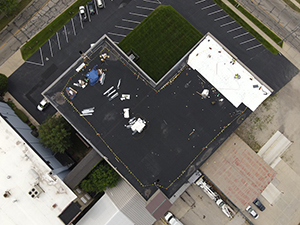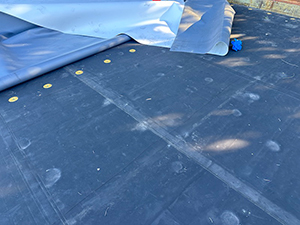
If you own or manage a commercial building, chances are your property has a flat roof system. Flat roofs are a popular choice in commercial construction because they offer practical design, maximize usable space, and are cost-effective. However, when these systems start to fail, many property owners delay action—often due to common misconceptions about the flat roof replacement process. While replacing a flat roof can feel overwhelming or seem like an unnecessary expense, understanding the facts can help you move forward with confidence. If you’re considering a flat roof replacement and want trusted, expert guidance, contact Brenneman Roofing in Brookline, MO today at (877) 370-6125.
Flat Roof Replacement Misconceptions
A Flat Roof Can Be Patched Indefinitely
One of the most common myths about flat roofs is the belief that they can be repaired indefinitely and never need full replacement. While minor repairs can help extend the life of a flat roofing system, every roof has a natural lifespan. Over time, repeated patching creates a “Band-Aid effect,” leaving underlying problems like saturated insulation, deteriorated decking, or widespread membrane failure unaddressed.
Patching may provide a temporary fix, but it does not address the root causes of damage. Eventually, recurring leaks and structural risks outweigh the cost savings of short-term repairs. For commercial property owners in Brookline, MO, ignoring signs of end-of-life roofing can lead to interior damage, mold growth, and disruption to your operations.
All Flat Roofs Leak Eventually—Even After Replacement

Another common myth that causes hesitation among building owners is the idea that all flat roofs will eventually leak, no matter how new or well-installed they are. This belief often stems from outdated roofing materials and poor installation practices of the past. Today’s flat roof systems, however, are engineered for long-lasting performance and excellent water resistance.
Whether you choose TPO, PVC, modified bitumen, or EPDM, a professionally installed flat roof with proper drainage and insulation is not prone to leaking. In fact, today’s roofing materials are backed by strong warranties and are built to withstand ponding water, UV exposure, and high winds—especially when maintained regularly.
Leaks in flat roofs are almost always due to neglected maintenance, poor workmanship, or failure to address aging components. With proactive inspections and regular upkeep, your new flat roof can remain watertight for 20–30 years or more.
Flat Roof Replacement Means Business Downtime
Commercial building owners often assume that a flat roof replacement will interrupt operations or require them to close temporarily. Fortunately, this is rarely the case. Skilled roofing crews are trained to complete replacements with minimal disruption to occupants and business activities.
In most situations, roof replacement can be performed in sections or during off-peak hours. Additionally, many modern roofing systems can be installed directly over the old membrane, depending on the building’s structural condition and local codes. This method, called a “roof overlay,” can reduce both labor time and costs.
In Brookline, MO, where business continuity is crucial, professional roofers like Brenneman Roofing understand how to plan and execute projects efficiently while prioritizing safety and minimizing impact on daily operations.
Replacement Is Always More Expensive Than Repairs
It’s easy to assume that a full replacement will cost significantly more than occasional repairs, but that isn’t always the case over the long term. Frequent repairs can add up quickly—especially if leaks cause internal damage or repeated service calls are needed. In contrast, replacing your flat roof offers peace of mind, reduced maintenance costs, improved energy efficiency, and a longer service life.
In fact, new roofing systems often come with energy-saving benefits, such as reflective surfaces that reduce cooling loads, and improved insulation that lowers heating costs. These benefits can provide returns on investment through energy savings, tax incentives, and property value increases.
Flat Roof Replacement Experts
Whether you’ve been delaying roof work due to concerns about cost, downtime, or durability, it’s important to get the facts about flat roof replacement. For commercial buildings, maintaining a functional and watertight roof is essential to protect your investment and maintain uninterrupted operations. Don’t let myths guide your decision-making—get expert advice today. Call Brenneman Roofing locally in Brookline, MO at (877) 370-6125 to schedule a consultation and explore the best options for your flat roof.
FAQ
How long does a flat roof last after replacement?
With proper installation and maintenance, modern flat roofs can last 20–30 years, depending on the materials used.
Can my new flat roof be installed over the existing one?
In many cases, yes. A roof overlay can be a cost-effective method, but a full inspection is needed to ensure the structure can support the added weight.
How do I know it’s time to replace my flat roof?
Warning signs include persistent leaks, ponding water, membrane bubbling, surface cracks, or if the roof is over 20 years old and repairs are becoming frequent.
What materials are used for flat roof replacement?
Common options include TPO, PVC, EPDM, and Modified Bitumen, each offering different benefits related to durability, energy efficiency, and cost.
Is flat roof replacement tax-deductible?
In many cases, roof replacement can qualify for tax deductions or credits, especially if energy-efficient systems are used. Consult your accountant for specifics.
